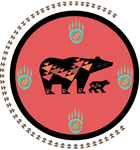As our work developed, we started using the following terms as specialized terms of art or shorthand for longer expressions that we didn’t want to keep repeating—especially throughout the interminable video meetings of the COVID-19 pandemic. In addition to serving as a shorthand, these terms and concepts helped CNCFR move away from Western approaches to our activities and toward more culturally responsive ones that center the communities’ we were working with. In much the same way that we understand that words matter in, e.g., the context of stigma and substance use disorder, we understood that many of the words we used at the outset are bound to histories of trauma and so were to be avoided. In addition, the use of these terms rather than their Western analogues served to remind us that we were not doing "business as usual"; instead, we needed to be intentional about doing this work, and using these terms signaled to ourselves and others to heed the context and proceed accordingly
Note: The glosses here are provided to give a sense of the terms rather than a complete lexicographic entry; others may use the terms differently.
- Indigenous Ways of Knowing (IWOK): IWOK are the practices, tools, methods, beliefs, etc. that Indigenous cultures have used for knowledge making and sharing since time immemorial. Because each Tribe may have different epistemic norms or practices, CNCFR spent time with each project discussing what success would look like for the program, who the knowledge bearers in the community are, how to measure program outcomes, etc. For more information, visit: https://cncfr.jbsinternational.com/IWOK
- Information Gathering: Where traditional Western approaches to research and evaluation address themselves to "data collection", we took to talking in terms of "information gathering" instead. There were a few reasons for this. First, the history of settler research in Indian Country is replete with troubling and unethical research practices; sadly, this is not merely historical, but includes at least some of the contemporary context. For better or worse, the use of the expression "data collection" is closely associated with those practices, and if we could take small steps to avoid contributing to this trauma while doing our work, we thought we should. Second, there are some who distinguish "data" from "information", with the former being "raw" or "uninterpreted" (especially quantitative data) and the latter being something like, "data transformed through analysis." Because we were seeking a holistic understanding of the efficacy of programs (i.e., how they affected community well-being in addition to how they affected participants) and using IWOK (esp. meaning making interviews with Elders and other knowledge-holders), talk of "data collection" felt reductive. Conceiving of our work as "information gathering" allowed us to avoid terms tied to historical trauma while conveying the sense to the communities we worked with that they had knowledge that we would gather in one place, synthesize, and share back with them.
- Meaning Making: Given the tools CNCFR used, including mind mapping and storytelling approaches, some of the material gathered took the form of artistic expression (e.g., drawings, letters to oneself) and stories. In addition, a common issue with outsiders conducting research in Tribal communities has been that the researchers misunderstand or misinterpret the significance of various data, leading to misleading or false research findings. Ensure the apt understanding of the mind maps and stories while avoiding the latter issue, CNCFR engaged in "meaning making" discussions with participants and knowledge holders to get their explanations of the significance of these materials and the preliminary results. Tribal communities and researchers to jointly host meaning-making sessions with research participants, key stakeholders, or the community at large once data collection and analysis is complete, providing an opportunity for researchers to transparently share results and explain their process for interpreting findings to the community, while also empowering the community to provide their input, feedback, and recommended corrections.
- Mind Mapping: Mind mapping is a process that allows a group to explore ideas collectively using graphics, imagery, and metaphor. CNCFR’s practice of mind mapping was grounded in the oral tradition and IWOK and involved groups working through the following steps collaboratively: creating a picture, identifying activation words, building out/expanding upon those activation words, and reflecting through collective discussion. The aim is to ultimately have the map tell the story more holistically. Mind mapping was most frequently used to identify key cultural values, theories of change, and outcomes of interest for the evaluation; often it identified cultural metaphors that informed evaluation research questions, shaped information gathering processes, and acted as a sort of Indigenous logic model for the projects.
- Storytelling: Because many Tribal cultures are more strongly oriented toward the oral tradition, CNCFR developed a storytelling methodology that respected the oral tradition and enabled the community to talk about their proposed program in their own words and in their own way. As part of our processes, we developed a guided storytelling tool developed in coordination with CNCFR’s IWOK workgroup, which started by simply asking our new partners to tell us about their community and the story of their program.


